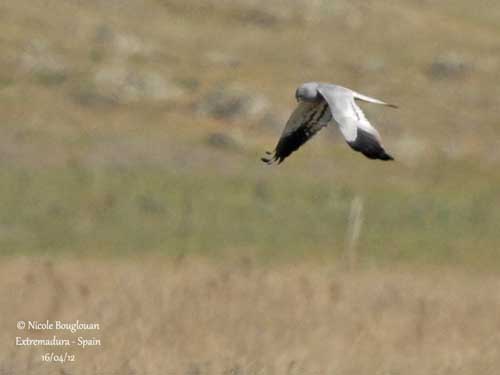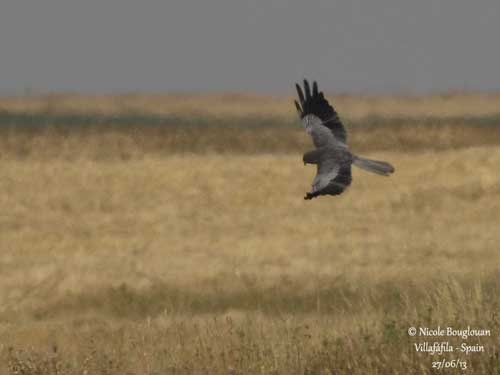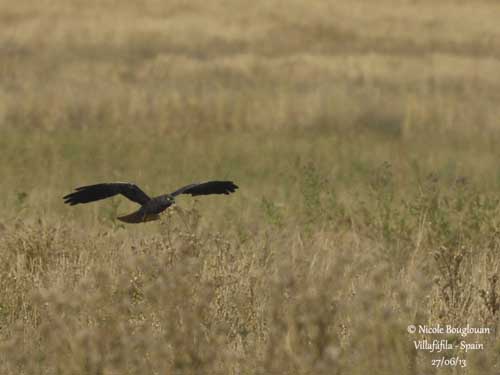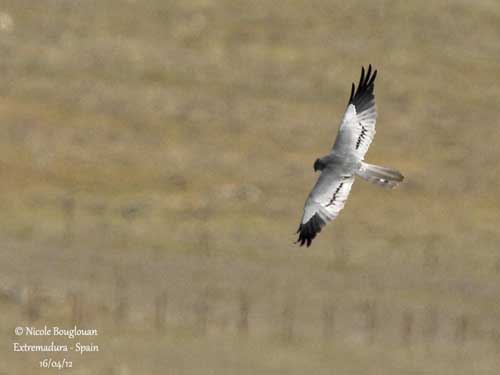
Fr: Busard cendré
All : Wiesenweihe
Esp : Aguilucho Cenizo
Ital : Albanella minore
Nd: Grauwe Kiekendief
Sd: Ängshök
Photographer:
Nicole Bouglouan
PHOTOGRAPHIC RAMBLE
Text by Nicole Bouglouan
Sources:
HANDBOOK OF THE BIRDS OF THE WORLD Vol 2 by Josep del Hoyo-Andrew Elliot-Jordi Sargatal - Lynx Edicions - ISBN: 8487334156
GUIDE DES RAPACES DIURNES – Europe, Afrique du Nord et Moyen-Orient de Benny Génsbol – Delachaux et Niestlé – ISBN : 2603013270
ENCYCLOPEDIE DES OISEAUX DE FRANCE ET D’EUROPE – de Peter Hayman et Rob Hume - Flammarion – ISBN : 2082009920
BirdLife International (BirdLife International)
Wikipedia, the free encyclopaedia
Montagu’s Harrier
Circus pygargus
Accipitriforme Order – Accipitridae Family
BIOMETRICS:
Length: 43-50 cm
Wingspan: 97-115 cm
Weight: M: 227-305 g – F: 320-445 g
DESCRIPTION:
The Montagu’s Harrier is an elegant bird of prey, often seen flying and soaring above open areas. Very agile in flight, its hunting behaviour is spectacular.
The adult male in normal morph has grey plumage with some black markings. On the wings, the primaries are black, and there are black bands across the secondaries, with one band above and two below. The mantle is grey whereas the rump is whitish. The tail is grey, with barred outer rectrices.
On the underparts, head and upper body are grey, whereas the lower underparts are whitish streaked rufous.
The head is grey. The hooked bill is black with yellow cere. The eyes are golden-yellow. Legs and feet are yellow.

The adult female in normal morph is very similar to the Hen Harrier female, but slightly paler. On the upperparts, she is dark brown with paler median coverts. The rump is white and the tail is barred.
The underparts are buff-white with conspicuous dark bars across the underwing. The tail is barred. Throat and breast are streaked dark, and are darker than belly and vent which are finely streaked brown.
On the head, the ear-coverts’ area is dark and contrasts strongly with the white eye area. The bare parts are as in male.
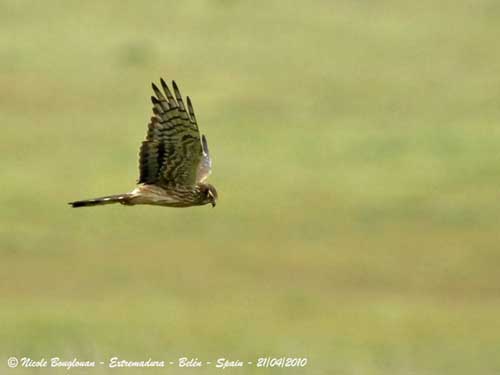
The juvenile has darker upperparts than female and the underparts are rufous and unstreaked.
There is a fairly rare melanistic morph, with blackish male and chocolate-brown female. In spite of the dark plumage, the pattern of the species is usually slightly visible.
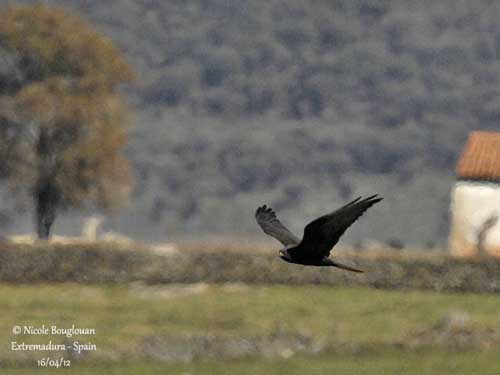
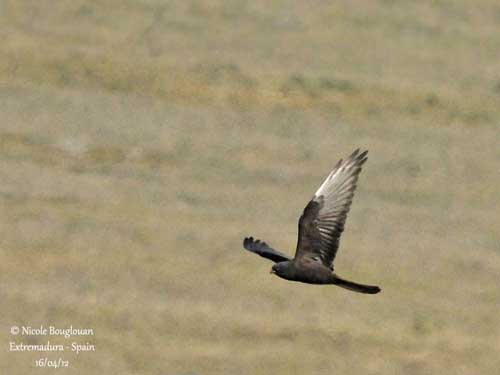
VOICE: SOUNDS BY XENO-CANTO
The Montagu’s Harrier is usually silent, but it becomes noisy during the breeding period and near the nest.
The flight displays are accompanied with rapid, harsh “kekeke” or “kaillek-kaillek”. When the female receives the food from the male in flight, she gives strident “psiii”. The alarm call is a series of “jick jick jick”.
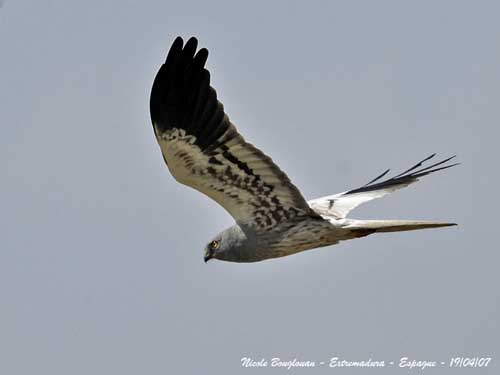
HABITAT:
The Montagu’s Harrier frequents usually open areas with flat or undulating ground. It can be found in grasslands and meadows, cultivated fields and fallow fields, heath, moors, marshes, wet areas near ponds and lakes and cultivated steppes.
It hunts over open areas and remains mainly at low elevation, but in the wintering grounds of Asia and Africa, it can be seen between 1500 and even 4000 metres of elevation.
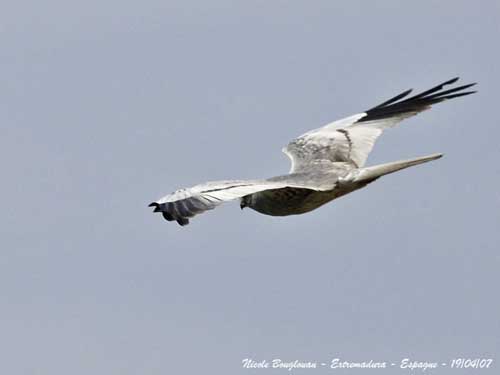
RANGE:
The Montagu’s Harrier breeds in NW Africa and in S and C Europe. It winters in Africa, south of the Sahara, Indian subcontinent, and S to Sri Lanka.
This species leaves the breeding grounds in August-September, and returns in April-May. These birds usually migrate in groups on broad fronts.
BEHAVIOUR:
The Montagu’s Harrier feeds on varied ground preys such as birds and their chicks, small mammals (voles), lizards and large insects (which are important on the wintering areas). The avian preys such as larks and partridge chicks are also eaten.
It hunts by flying low and slowly. The bird quarters an area in straight lines upwind. When the prey is detected, it drops onto it and catches it with the talons.
Less heavy than the Hen Harrier and the Western Marsh Harrier, the Montagu’s Harrier performs an agile flight when hunting and pursuing preys.
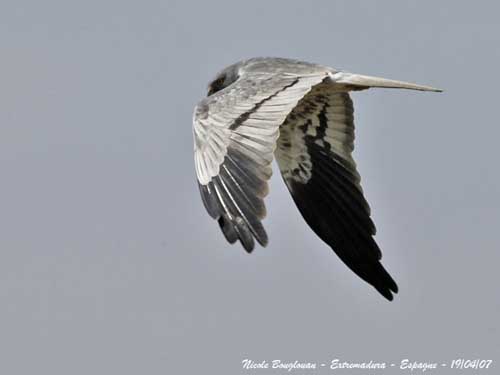
The Montagu’s Harrier can be seen perched on fences, rocks or trees, but it roosts on the ground among the vegetation. Some roosts may gather numerous birds. However, it can be a solitary nester, but they sometimes form loose colonies of about ten pairs.
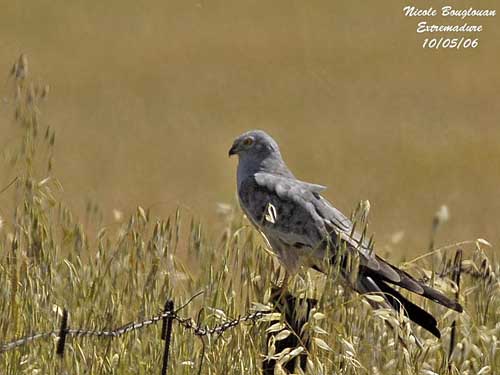
When they arrive at the breeding grounds, the pairs form within the territory. These raptors usually return to the same site every year and mate again together. The male may be polygamous, with two females and later, with two broods.
The courtship displays start as soon as they return to the territory. The male “dances” above the nest area. Both mates circle together high in the air, and they roll and tumble together with held legs and outstretched talons. The male may also pass food to the female and she may do the same. The flight displays of this species are elaborate and spectacular, due to their agility in flight.
FLIGHT:
The Montagu’s Harrier performs soaring flight with well raised wings, mainly in circular soaring. In direct soaring, the wings are less raised. It makes powerful wingbeats and flies easily.
The hunting soaring-flight is slow, interspersed with soft wingbeats.
This bird has very graceful flight.
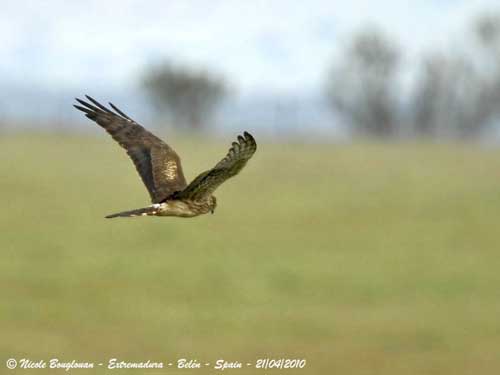
REPRODUCTION:
The breeding season occurs in May-June, and as soon as mid-April in NW Africa.
The nest is mainly built by the female, in dense tall vegetation, usually in fields, grasslands, reedbeds and other types of bushy areas. This is a small, shallow platform made with grass stems and twigs.
The female lays 3-5 eggs, and incubates during about 28-29 days. The chicks are fed by both parents. The female gives them the preys caught by the male, and passed to the female while flying near the nest.
The chicks are covered with white down, slightly tinged buff. They fledge at 30-40 days old, and start to hunt alone two weeks later, mainly large insects. They are sexually mature at 2-3 years old.
The breeding success varies according to human disturbances, predation and food availability.
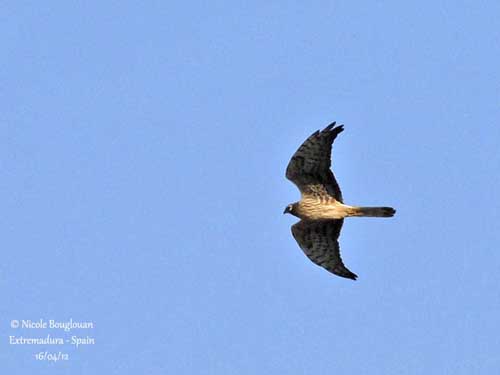
DIET:
The Montagu’s Harrier feeds on small birds and their chicks, small mammals (voles), large insects and lizards. Some snails, earthworms, amphibians and snakes can also be taken.
The avian preys are mainly larks, buntings and pipits, and the insects are grasshoppers, dragonflies and coleopterans. On the wintering grounds, they feed mainly on small birds, lizards and orthopterans.
PROTECTION / THREATS / STATUS:
The Montagu’s Harrier is threatened by the over-use of pesticides, agriculture expansion, destruction of the nests following harvesting of crops, reduction of food resources such as small mammals and birds, due to different agriculture practices.
However, the populations are evaluated as least Concern by Birdlife International, in spite of several declines throughout the range.
